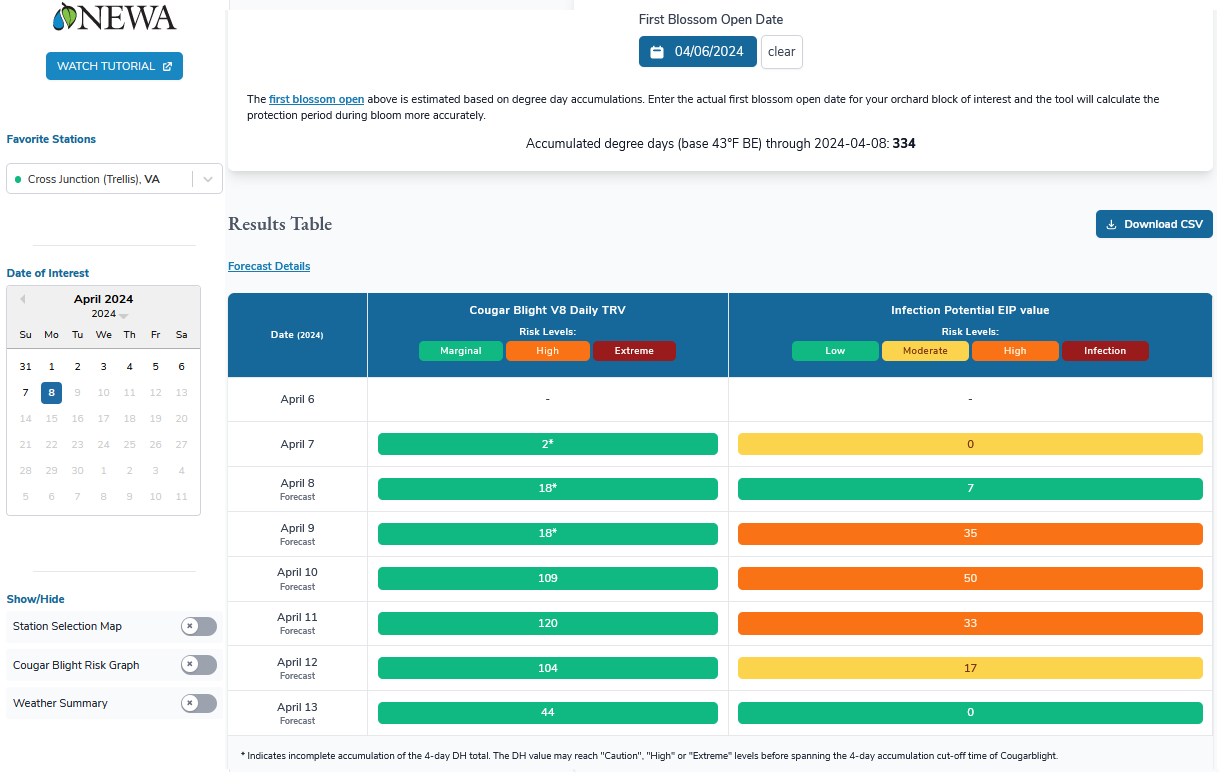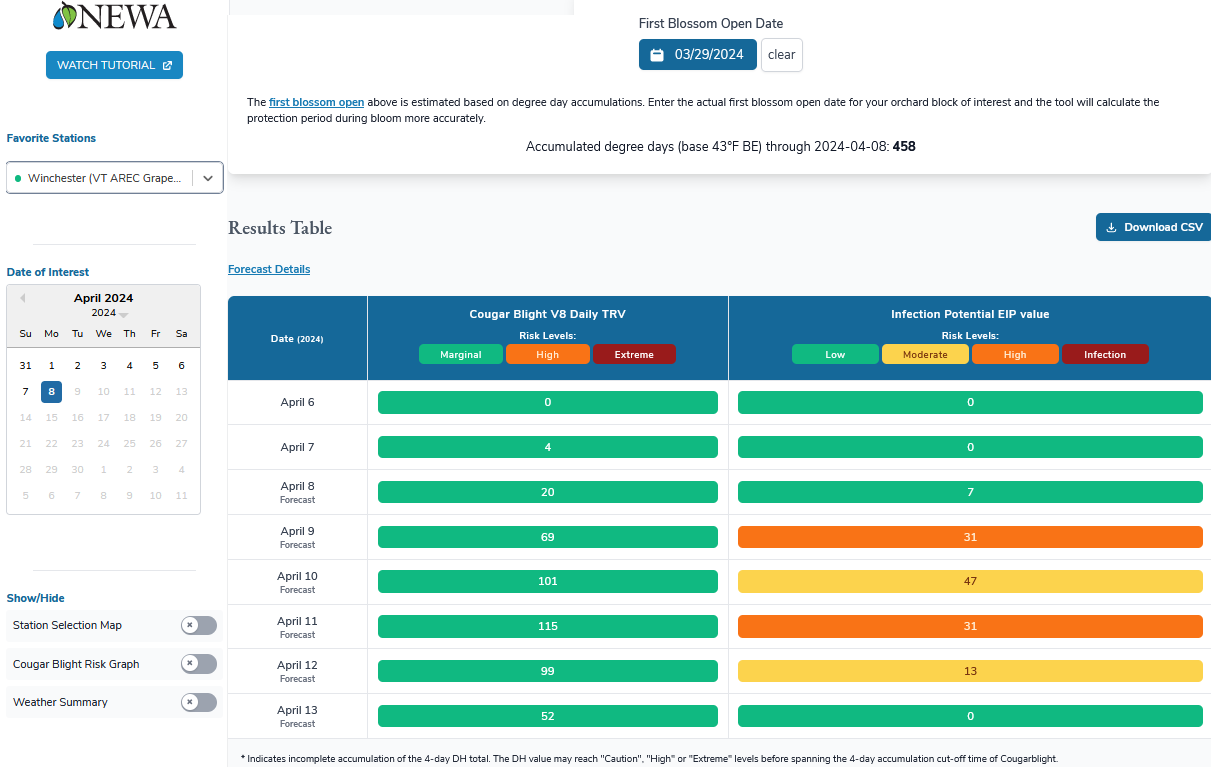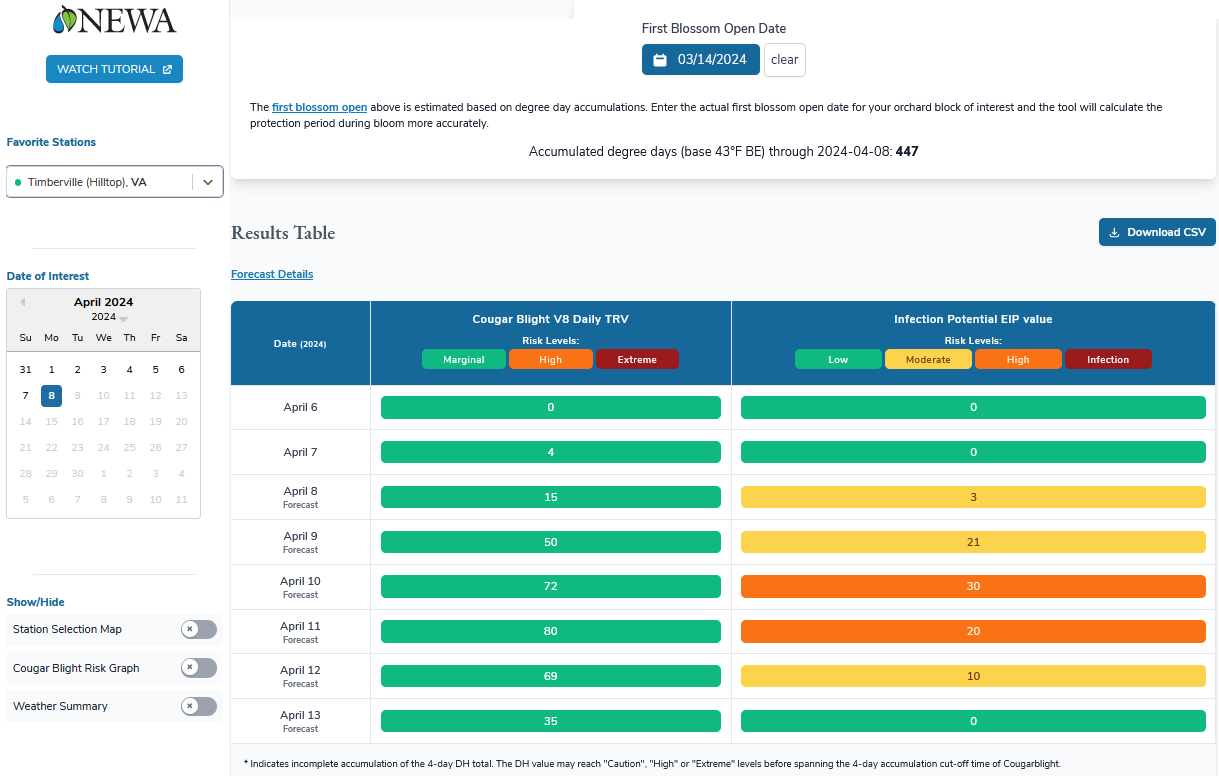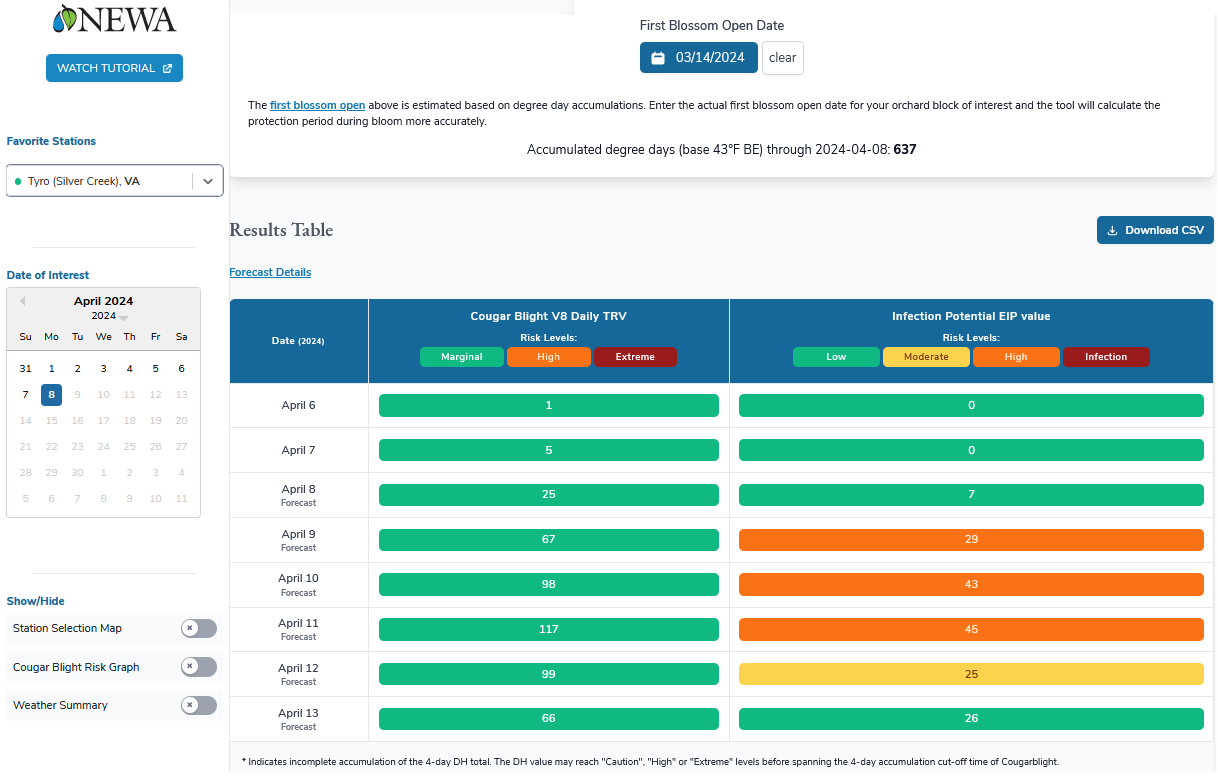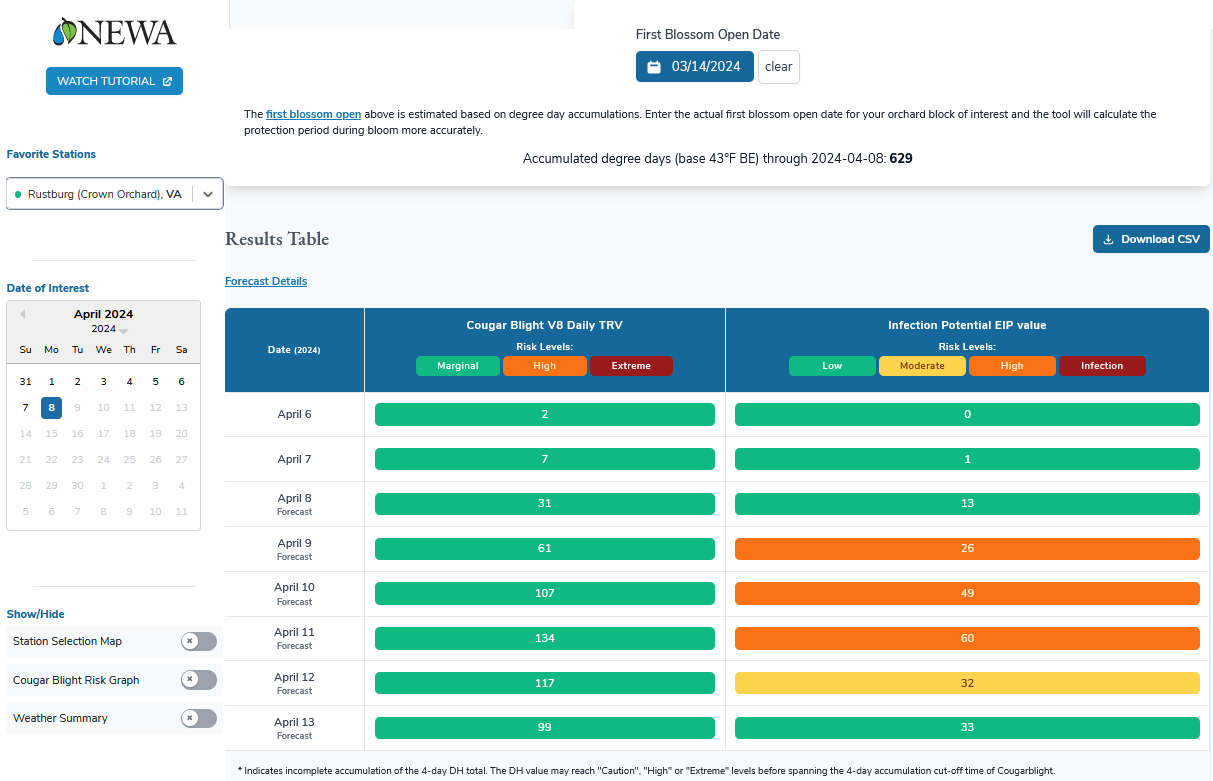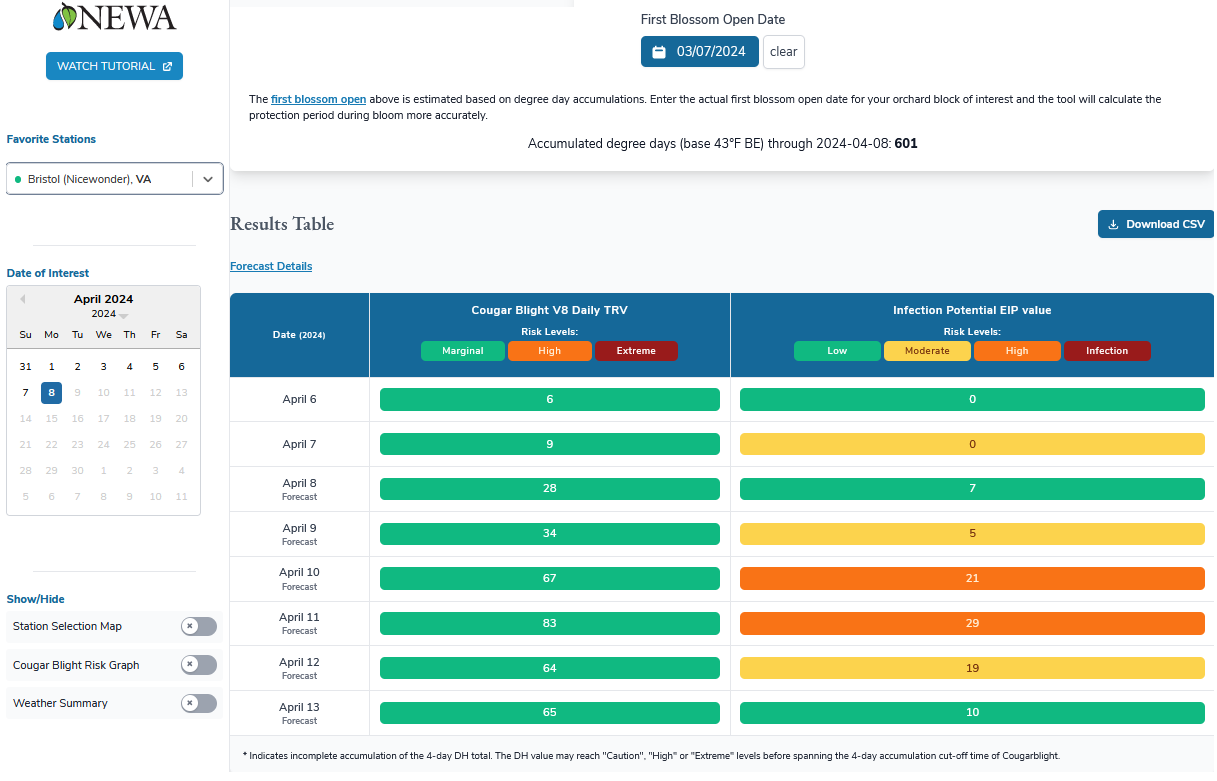1. Apple Scab and Rust Infections in All Virginia With Rains From 9 to 12 April; 2. Fire Blight Risk Low But Keep Looking at the NEWA EIP/RIMpro Models
1. APPLE SCAB, RUSTS, POWDERY MILDEW: If the weather forecast for 9-12 April becomes a reality, and we do get rain events predicted, according to NEWA apple scab model we will get a very strong apple scab and Juniper rust infection on 10 April into 12th April in all apple growing regions: Bristol, Fincastle, Rustburg, Tyro, Timberville, Winchester, Manassas, and many others. According to RIMpro model these rain events warrant a top quality fungicide mixture of a single site fungicide with a contact multi-site fungicide. The biggest advantage of the RIMpro apple scab model in comparison to the NEWA scab model, is in that RIMpro apple scab model allows you to actually determine the fate of the groups of released apple scab ascospores during these rain events and predict to you how severe the infection by them will be. None of the models I have seen can do that. Thus by seeing the severity of infection you expect, you can gauge your response by selection of fungicides you will use.
So, the growers who have subscribed to RIMpro can profit from knowing when to apply a very effective fungicide mixtures for this oncoming wet period, if the weather forecast for 9 – 12 April becomes reality, by seeing in the model the destiny of the ascospores that will be released with these rain events, in terms of their germination and success in infection. RIMpro model shows the dynamic destiny of ascospores of apple scab fungus Venturia inaequalis from maturing in the leaf litter, ejection into the air, germination, and all the way up to their final destiny on green leaves – indicating infection or not. It is a dynamic model unlike the static model offered in the NEWA’s network. In the population models like the RIMpro apple scab model is, the infection biology is split up in a chain of subsequent processes for each ascospore group, and in each sub-process (release, germination, infection) the latest current scientific knowledge on ecology, biology, and epidemiology about that sub-process is applied and used in the model output prediction. RIMpro is a great tool for efficient scab management and used in commercial orchards in over 40 countries worldwide.
RIMpro apple scab model accounts for the different destiny of the the first apple scab ascospore that lands on a leaf and the last spore that lands on the leaf. In a hypothetical example, the first ascospore was maybe released in the evening, and the last ascospores were released the next morning, and that time of release will impact their success in infection. The NEWA scab model (and all other scab models) only see one rain or wetting event. Such static models will start counting the infection hours in the morning because there is no ascospore ejection at night and that is all. In contrast, RIMpro model dynamically accounts for a very low ejection rate of ascospores when rain starts at night, and keeps track of these spores. When temperature changes or when the daylight arrives, RIMpro shows that ascospores accelerate in ejection. RIMpro keeps track of all the groups of ascospores and their destinies under variable weather conditions. Therefore, a high infection risk from scab occurs only when large number (many) ascospores infect the leaf at the same time.
For the oncoming infection, a combination of Inspire Super or Excalia or Sercadis or Fontelis plus mancozeb would be necessary before the rain events on 10 April. Keep in mind that the SDHI (FRAC Group 7) fungicides I state above will NOT be effective for Juniper rusts but will be very effective for powdery mildew control as well. You can use the SDHI in this when the rust is not a very big concern for your location, so if that is the case add 10-16 fl oz/100 gal of LI700 to it as this boosts the absorption of SDHI-s into the green tissue and allows longer residual protection throughout the rain events. Where Juniper rusts that infect apple are a top concern besides scab, DMI fungicides like Inspire Super, Procure, Rally, Rhyme, Cevya, Sonoma and others in mix with mancozeb should be applied before the rain events of 9-12 April. DMI-s are the most effective systemic materials for control of both apple cedar rusts and apple scab fungi. DMI-s are especially needed as we have seen the galls on Junipers become gelatinous and orange, meaning they are releasing sthe spores that infect apple leaves and fruit, during the severe rains we had 1-3 April. From now on, until 2nd cover make sure you add a DMI (FRAC 3) fungicide every 14 days in mix with mancozeb. In between the 14 days DMI mix with mancozeb you can use SDHI-s in mix with mancozeb for apple scab control. Systemic fungicides are needed because the leaves will rapidly expand in size in the next several weeks with warm weather and it is the best practice to have a systemic fungicide in the green tissue while it expands durign the warm rains. Dilution of fungicide residue is not only caused by rain, but with the leaf tissues expansion as well. Be vigilant and keep looking at the prediction models every day, twice a day (morning and evening) to see if any of these predictions will change and apply your disease control materials accordingly. A good spray period will be 8 – 9 April before the rains on the 10-12 April start, because the closer you are to the infection period you would achieve maximum coverage of the expanding green tissue.
2. FIRE BLIGHT: We are in slow transition from tight cluster to pink in ‘Fuji’ in Northern VA. Pink Lady is 20% bloom. Based on the weather forecast as it stands now, due to low temperatures for showers predicted in NWS on 9-12 April we do not expect infection by fire blight in Winchester. However, keep looking at the models as the infection prediction can change in a less then 24 h notice due to weatehr forecast instability. Hence please keep looking at the NEWA’s EIP Model and examine the print screens showing only orange boxes and EIP over less than 100 below, which is of no risk for streptomycin spray application (Source: https://newa.cornell.edu/fire-blight). As you get closer to the 10th April, weather forecast will get more reliable. If the EIP value changes to 100 and the color of the box changes to dark red indicating “Infection”, find a good window to apply streptomycin on any open pear and apple flowers in your orchard.
